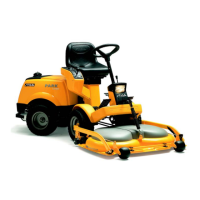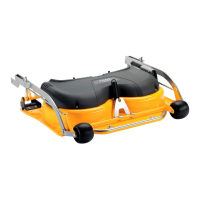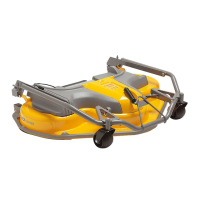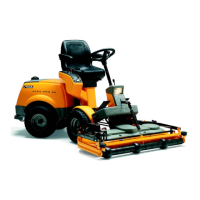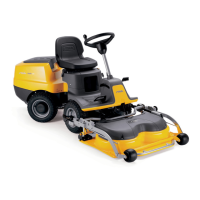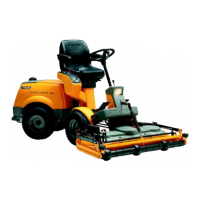ENGLISH
EN
5.2 PREPARATIONS
Unless otherwise stated, all service and
maintenance must be carried out on a stationary
machine when the engine is not running.
Prevent the machine from rolling by
always applying the parking brake.
Prevent unintentional starting of the
motor by disengaging the drive,
shutting off the engine and
disconnecting the spark plug cable or
removing the starter key.
5.3 CLEANING
To reduce the risk of fire, keep the
engine, silencer, battery and fuel tank
free from grass, leaves and oil.
To reduce the risk of fire, regularly
check the machine for oil and/or fuel
leakage.
When washing the machine with water under high
pressure, do not point the jet directly at the
transmission.
Do not point jets of water directly at the engine.
Use a brush or compressed air in order to clean it.
5.4 ENGINE OIL
Change engine oil the first time after 5 hours of
operation, and subsequently after every 50 hours
of operation or once a season. Change oil when the
engine is warm.
Always use a good grade of syntetic oil (service
grade SF, SG or SH).
Change the oil more often (after 25 hours of
operation or at least once a season) if the engine
has to operate under demanding conditions or if
the ambient temperature is high.
The engine oil may be very hot if it is
drained off directly after the engine is
shut off. So allow the engine to cool a
few minutes before draining the oil.
1. Oil drain pipe (metal fig. 7):
Unscrew the oil drain plug at the end of the pipe.
Collect the oil in a collection vessel. Then take
the oil to a recycling station. Do not allow oil to
get on the V-belts.
2. Screw in the oil drain plug. Make sure that the
fibre gasket and the O-ring inside the plug are not
damaged and that they are in the correct place.
3. Remove the dipstick and fill up with new oil.
Oil capacity: 1.4 litres
Oil type, summer (> 4ºC): SAE-30
(SAE 10W-30 can also be used. However, oil
consumption may increase somewhat if 10W-30 is
used. Therefore, check the oil level more regularly
if you use this type of oil).
Oil type, winter (< 4ºC): SAE 5W-30
(if this oil is not available, use SAE 10W-30).
Use oil without any additives.
Do not fill with too much oil. This can cause the
engine to overheat.
After filling up the oil, start the engine and idle for
30 seconds. Stop the engine. Wait for 30 seconds
and then check the oil level.
Check to see if there is any oil leakage. If
necessary, fill up the oil up to the “FULL” mark.
5.5 AIR FILTER - ENGINE
Change the pre-filter once a year or every 25 hours
of operation.
Clean the paper filter insert once a year or after
every 100 hours of operation, whichever comes
first.
NOTE! Both filters should be replaced/cleaned
more often if the machine operates on dusty
ground.
1. Remove the protective cover on the air filter
(fig. 10).
2. Dismantle the paper filter insert and the foam
pre-filter. Make sure that no dirt gets into the
carburettor. Clean the air filter housing.
3. Replace the pre-filter.
4. Clean the paper filter insert as follows: Knock it
lightly against a flat surface. If the filter is very
dirty, change it.
5. Assemble in the reverse order.
Petroleum-based solvents such as kerosene may
not be used for cleaning the paper filter insert.
These solvents can destroy the filter.
Do not use compressed air for cleaning the paper
filter insert. The paper filter insert must not be
oiled.
5.6 SPARK PLUG
Clean the spark plug after every 100 hours of
operation or once a season. For replacing a spark
plug, a spark plug sleeve A and a torsion pin B are
provided in the accessories bag.
The engine manufacturer recommends:
Champion RC12YC.
Correct spark gap: 0.7 - 0.8 mm (fig. 11).
5.7 COOLING AIR INTAKE - ENGINE
The engine is air-cooled. A blocked cooling
system can damage the engine. The engine should
be cleaned at least once a year or every 100 hours
of operation.
Remove the fan casing. Clean the cooling fins on
the cylinder, the fan and the rotating protective
grille. Clean more frequently if mowing dry grass.
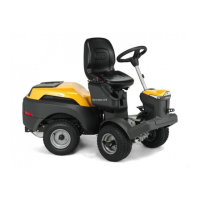
